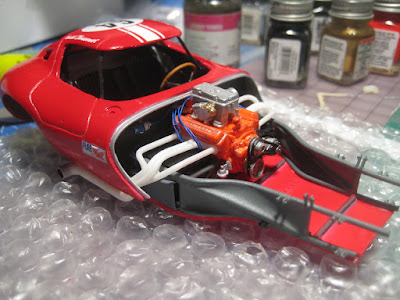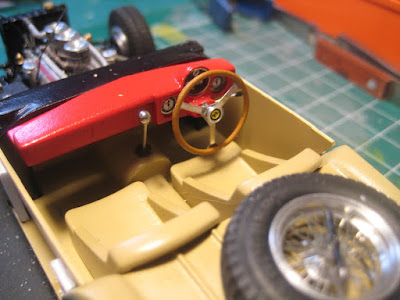The story of the Cheetah has been told elsewhere; suffice it to say that this brutal little device didn't provide as much competition for the Cobra as its founder Bill Thomas had hoped; but it did capture the imagination of a generation of car-crazy kids with its testosterone-infused shape. Plenty of other failed sports racers have sunk without a trace, but not the Cheetah. Other sports racers may have been prettier (GTO, Daytona Coupe), or more pragmatic (Corvette Grand Sport), or more traditional (Cobra), but the Cheetah stood out with its outrageous proportions.

The Historic Racing Miniatures resin model is similar to HRM's Miller 91, in that it is very detailed, relatively easy to assemble compared to the MFH kits but with some traps here and there, and not assisted by the typed instruction sheet. But we will forgive HRM's founder, Harold Bradford, because where else are you going to find stuff like this?


Paint went on it a while back, and it has been sitting hardening while I worked on a couple of other projects. The approach of two or three mist coats, 20 minutes apart, before a flood coat is illustrated.


Done carefully, this provides a nice smooth surface with minimal orange peel. If I were building a show car, I'd still be wet sanding in increments from 2400 to 12,000 grit, then polishing; but I suspect that leads to a finish which is better than the car was in 1964.

The decals are from Vintage Racing Miniatures and are excellent. They take a long while to soak off the paper backing, but once off are strong and very opaque. The clear coat went on like the red: two or three mist coats 20 minutes apart, then a flood coat.

Decals are provided for nine different versions, including the Cro-Sal roadster which would have required cutting off the roof. Of the 9, only one is definitely known to have finished a race (second in class, Willow Springs, 1964); the others either DNFed, or period photos don't provide enough info to identify the race and date.

Car 64, as in the version here, DNFed at Road America in 1964. (In retrospect I should have blocked most of the holes in the hood to accurately model this particular car at this particular race.) The car ran on white steel wheels in that race, rather than mags, due to needing tires for the race which was run in the rain. The Bill Thomas website has more on this car and its driver, Budd Clusereth.
Rear axle is an independent Corvette unit with coil-overs replacing the transverse leaf spring, a good thing as the driveshaft is about 6" long and wouldn't allow a solid axle to move around much.

Once you understand which way is up, or front, on the various bits, it all goes together fine.

Interior and floor pan have been installed, along with the firewall and belly pan.

What a cramped cockpit!

Historical photos show the gauge layout was completely random and varied from car to car. With one large dial, to the right, and four little ones clustered around the steering wheel, the tach had to be well out of the driver's line of sight.

Next I am trying to figure out the footwells which don't seem to fit very well. After that will be the engine and front chassis bits. Stay tuned!
























































